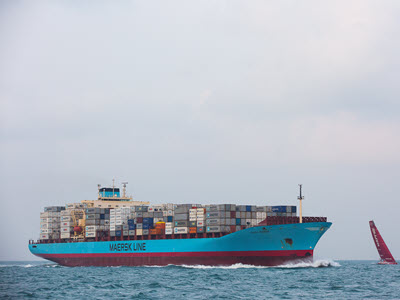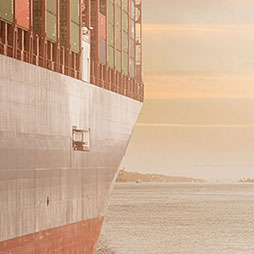Interview from the Center for Innovation, Trade, and Strategy
Geoeconomic Crossroads
The Strait of Malacca’s Impact on Regional Trade
The Strait of Malacca represents one of the most strategically, economically, and politically significant maritime chokepoints in the world. Therefore, it is of critical importance to the Southeast Asian countries that border or rely on it as well as to great powers with interests in the Indo-Pacific. To understand how Southeast Asia views this body of water, NBR fellow Wyatt Weekes interviewed Kaewkamol Pitakdumrongkit of the S. Rajaratnam School of International Studies RSIS.
The Strait of Malacca is one of the most significant waterways for maritime trade. However, climate change and other tensions have made it increasingly vulnerable to both environmental and geopolitical risks. What are the greatest threats to the security of trade in this region?
The Strait of Malacca is a vital part of the Indo-Pacific because it is one of the key sea lanes linking two oceans—the Indian and the Pacific. Sea lanes such as this are particularly economically and strategically important to the Indo-Pacific because it has nine of the world’s ten busiest seaports, and about 60% of global maritime trade passes through this region. The economies in the region together account for 60% of global GDP. Its biodiversity is the world’s greatest, housing about 3,000 marine species, which reflects the region’s environmental importance.
The Strait of Malacca and the Indo-Pacific region are facing several threats. First, the strait is a chokepoint. With about 90,000 ships passing through it every year, congestion creates navigational hazards. When collisions happen, they delay or disrupt the flow of goods and can cause environmental damages. For example, in July 2021 the United Kingdom–flagged containership Zephyr Lumos and the Maltese-flagged bulk carrier Galapagos collided along the Strait. The accident not only damaged both vessels but also resulted in an oil spill.
The second threat is piracy. While the frequency of sea-borne robberies had fallen since 2006, the number has recently increased. According to the Regional Cooperation Agreement on Combating Piracy and Armed Robbery against Ships in Asia Information Sharing Centre (ReCAAP ISC), in the first half of 2023 the strait witnessed 38 piracies, a 41% rise of such occurrences relative to 2022. Piracy complicates navigation and can disrupt maritime trade in the region.
Moreover, environmental threats stemming from climate change have recently worsened. Global warming exacerbates sea-level rises, increases the frequency and severity of natural disasters (e.g., typhoons and floods), and alters fish migration patterns. Land erosion and reduced fish populations (resulting from rising temperatures) jeopardize the livelihood of coastal communities. In addition, extreme weather delays maritime transportation of goods through the Strait of Malacca, which can disrupt regional supply chains.
Finally, geopolitical factors pose additional threats. U.S.-China competition has resulted in protectionist measures such as U.S. tariffs on Chinese goods, most of which have been in place since the Trump Administration, and U.S. export controls on advanced semiconductors and semiconductor manufacturing equipment targeted at China. These measures reduce the trade volume and value between two major economies, resulting in decreased volume and value of sea-borne trade passing through the strait. Because the U.S., Chinese, and other regional economies are intertwined in Indo-Pacific supply chains, any future trade-distorting measures by Beijing and Washington will further affect regional trade in goods and services.
Situating the Malacca Strait in the wider Indo-Pacific context, it would also be affected by any crises in the South China Sea—where several claimants have maritime and territorial disputes. As a result, the South China Sea is a flashpoint and poses risks to regional peace and stability. Clashes among the claimants could escalate into full-blown armed confrontations, disrupting the flow of goods across the strait and global supply chains.
Several East and Southeast Asian countries rely on the Strait of Malacca as a critical link in maritime trade routes. How well are these countries prepared to adapt to any potential disruptions? What steps should they be taking now to be better prepared?
Various regional states have been able to address the threats described above. Regarding navigational accidents, the vessel traffic systems provided by the governments of Malaysia and Singapore have helped monitor ship movements and enabled the involved agencies to manage traffic through the Strait of Malacca. Regarding counterpiracy efforts, littoral governments have ramped up their cooperation on policing and security measures. Examples encompass joint naval patrols by Indonesia, Malaysia, and Singapore, as well as information-sharing about incidents and suspicious activities. While piracy in the strait rose during the first half of 2023, existing mechanisms and deepened international cooperation should suffice to help the authorities bring down the number of incidents. Further steps such as increased use of data analytics and more real-time data collection and sharing can be taken to better address these threats.
To tackle climate change, all Indo-Pacific states endorsed the Paris Agreement. This binding document has two broad objectives: (1) to maintain “the increase in the global average temperature to well below 2°C above pre-industrial levels,” and (2) to cap the temperature increase at 1.5°C above pre-industrial levels. However, meeting these goals is challenging for several Southeast Asian countries. Climate change solutions require resources ranging from technical to financial, and even developing nations often have insufficient resources to reduce carbon emissions and achieve net-zero. Thus, for efforts in the region to be successful, they will require funding and capacity training from wealthier states or international organizations. There are positive developments on this front. For example, the Asian Development Bank in December 2022 approved a $73 million financing package for Cambodia. This fund will help the country enhance its climate resilience and restore its depleted fish stocks caused by extreme weather. In June 2023 the United States Agency for International Development (USAID) signed an agreement with the ASEAN Centre for Energy to advance the decarbonization efforts of the Association of Southeast Asian Nations and accelerate its clean energy technology deployment. Such moves are steps in the right direction and should be further encouraged.
As far as geopolitical challenges are concerned, several regional states have hedged against the uncertainties caused by the Sino-U.S. rivalry by fostering ties with both powers. They have also reached out to “third parties”—primarily the European Union—to support their hedging strategies. ASEAN adopted the ASEAN Outlook on the Indo-Pacific (AOIP) in 2019 to shape their response to strategic competition involving extraregional countries. The AOIP reaffirms the principle of ASEAN centrality and the important role of ASEAN in shaping future developments of governance architecture in the Indo-Pacific.
On the South China Sea issue, regional initiatives were put in place for crisis prevention and management. In 2014, 21 nations including China and the United States signed onto the Code for Unplanned Encounters at Sea (CUES), which establishes communication channels and offers safety and maneuvering procedures to be taken during unplanned maritime encounters. However, the nonbinding nature of CUES and the fact that it only applies to naval vessels and aircraft might not provide countries with adequate tools to handle emergencies. The near collision between Chinese and Philippine coast guard vessels near Second Thomas Shoal in April 2023 exposes the gap in international maritime governance. One way forward is to make CUES a binding document and expand it to encompass coast guards.
Do you think efforts to adapt regional trade to mitigate the risks of disruption have the potential to undermine intra-ASEAN relations? Or will evolving trade ties strengthen the bonds between member countries?
The efforts to mitigate risks of disruption bode well for intra-ASEAN relations. Intensifying geopolitical dynamics and other threats have brought the ASEAN member states closer together. Their collective action manifests in several of the cooperation initiatives cited above. Also, the AOIP reflects the member states’ aspiration to make ASEAN a relevant and significant player in affecting regional developments.
Illustratively, the text states that “it is in the interest of ASEAN to lead the shaping of their economic and security architecture and ensure that such dynamics will continue to bring about peace, security, stability and prosperity for the peoples in the Southeast Asia as well as in the wider Asia-Pacific and Indian Ocean regions or the Indo-Pacific.”
In addition, the AOIP spells out four goals: (1) proffer an outlook guiding regional cooperation, (2) facilitate an enabling environment for peace, stability, and prosperity, (3) heighten ASEAN’s community-building and bolster existing ASEAN-led mechanisms such as the East Asia Summit, ASEAN +1 entities, and ASEAN Regional Forum, and (4) implement and explore other ASEAN priority cooperation areas such as maritime collaboration and sustainable development. The AOIP’s emphasis on the utilization of ASEAN and ASEAN-led mechanisms will not only enable ASEAN and its members to shape regional collaboration outcomes but also further enhance their bonds going forward.
How might the energy transition affect the role of the Strait of Malacca as a critical link in trade routes?
While the transition to clean energy is an emerging priority in Southeast Asia, completing this process is still a distant aspiration. In 2020 the energy mix of ASEAN member states consisted of oil (33%), coal (28%), natural gas (22%), and renewables (14%), reflecting the continued dominance of fossil fuels.
According to the 7th ASEAN Energy Outlook (2020–2050), without any policy intervention the region’s share of coal is expected to continue to remain at 25.9%, at least until 2025. For the ASEAN member states to meet their national and regional energy transition goals, approximately $800 billion in investment from 2021 to 2050 would be required, which is a quite challenging target. As the region’s full energy transition is less likely in the short term, progress on this front will have a limited impact on Asian energy trade and trading routes, including the Strait of Malacca.
Given recent efforts to strengthen U.S.-ASEAN relations, as well as China’s predilection for economic retaliation, do you think that China poses a significant threat to Pacific maritime trade?
The recent tightening of U.S.-ASEAN ties is reflected by the elevation of bilateral interactions to a comprehensive strategic partnership (CSP) at the 10th ASEAN-U.S. Summit in November 2022, on the occasion of the 45th anniversary of ASEAN-U.S. dialogues. At the fourteenth meeting of the ASEAN-U.S. Joint Cooperation Committee in May 2023, both sides reaffirmed their commitments to realize the CSP.
While the depth and breadth of ASEAN-U.S. ties as reflected in the CSP might suggest that ASEAN is leaning toward Washington, which could invite retaliation from Beijing, ASEAN gives similar treatment to its other dialogue partners. In short, the upgrade of the relations to a CSP is not unprecedented. ASEAN accorded this same status to Australia and China in 2021—with the latter agreement coinciding with the 30th anniversary of dialogue relations—and to India in 2022. In March 2023, both sides reiterated their CSP pledges and discussed ways to promote cooperation under this partnership at the 24th ASEAN-China Joint Cooperation Committee.
These actions help ASEAN evade the potential criticism of favoring one extraregional stakeholder over another and prevent possible retaliation. They also reflect ASEAN’s adoption of a neutral stance amid great-power competition. Going forward, ASEAN will seek to maintain this approach to minimize the likelihood of retaliations, which can hurt regional maritime trade.
Kaewkamol Pitakdumrongkit is Head and Assistant Professor in the Centre for Multilateralism Studies at the S. Rajaratnam School of International Studies (RSIS) of Nanyang Technological University in Singapore and a Nonresident Fellow at NBR.
This interview was conducted by Wyatt Weekes while a fellow in the Center for Innovation, Trade, and Strategy at the National Bureau of Asian Research



